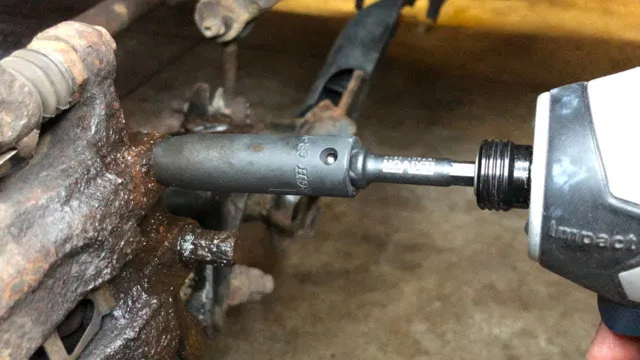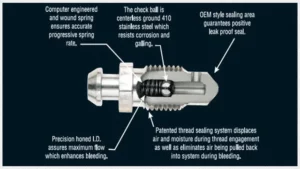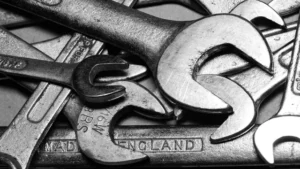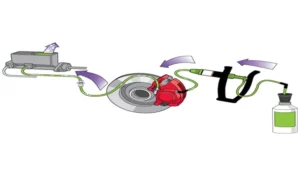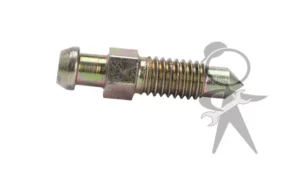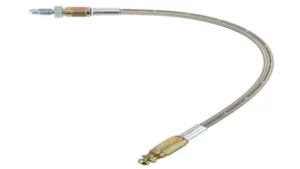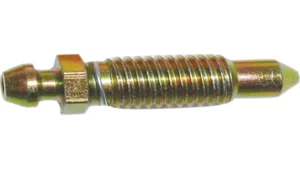Do you hear a hissing sound when you step on your brake pedal? Does your brake pedal feel spongy? These could be signs of a leaking brake bleeder screw. The brake bleeder screw is responsible for releasing air from the brake lines, ensuring that your brakes work effectively. However, when the screw is damaged or worn out, it can lead to brake fluid leaks, affecting the brake’s performance.
Fixing a leaking brake bleeder screw can be daunting, especially if you don’t have the right tools and expertise. But don’t worry; in this blog, we’ll guide you through the steps to fix it and get your brakes functioning optimally. So, sit back and take note; fixing a leaking brake bleeder screw is not rocket science!
Understanding the Issue
If you find your brake bleeder screw leaking, it’s important to fix the issue as soon as possible to ensure your brakes are working correctly. One possible solution is to replace the bleeder screw altogether. This involves removing the old screw and replacing it with a new one that fits your brake caliper.
If that doesn’t work, you can try reseating the screw to see if that fixes the leak. To do this, you’ll need to remove the screw, clean the area thoroughly, and then replace it, making sure it’s tight. It’s important to note that over-tightening the screw can actually cause more damage, so be sure to follow manufacturer guidelines and specifications.
If you’re not comfortable handling this issue yourself, it’s best to bring your vehicle to a professional mechanic who can diagnose and fix the problem for you.
Inspection of the Bleeder Screw
The bleeder screw is an essential component of a vehicle’s brake system. Its function is to allow the release of air and excess brake fluid from the system to ensure efficient braking. However, over time, the bleeder screw can corrode or become damaged, causing leaks and inefficiencies in the brake system.
Therefore, it is crucial to inspect the bleeder screw regularly to avoid these issues. In many cases, a simple visual inspection can reveal any signs of damage or corrosion on the screw. Additionally, it is recommended to replace the bleeder screw every two years or after any brake system work is performed.
Neglecting to inspect and replace the bleeder screw when necessary can lead to potentially dangerous brake failures. So, if you notice any issues with your brakes, don’t hesitate to take your vehicle to a professional mechanic to have it inspected, including the bleeder screw.
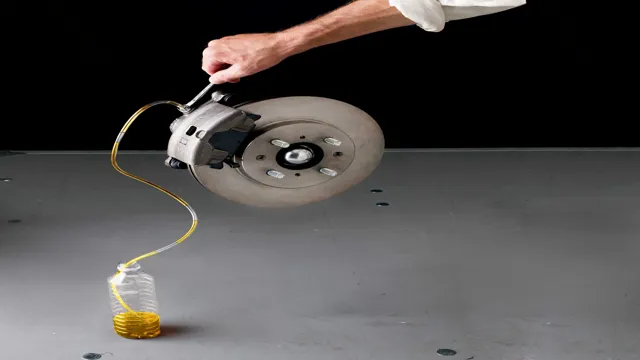
Identification of the Source of Leakage
When faced with a leakage issue, it’s important to first understand the source of the problem. Leakage can occur from various sources, including a damaged pipe, a faulty valve, or even a loose connection. Identifying the source can be a challenging task, but it’s crucial to find the root cause to prevent further damage and costly repairs.
An effective way to detect the source of leakage is through visual inspection, checking for any visible signs of damage. Additionally, you can use leak detection devices to locate the source of the problem. These devices use sound waves or vapor detection to pinpoint the origin of the leak.
Once the source of the leakage is identified, it’s essential to act quickly to prevent further damage. By taking immediate action, you can potentially save yourself from expensive repairs and the inconvenience of having to deal with regular water leaks.
Tools Needed for the Repair
When attempting to fix a leaking brake bleeder screw, there are a few tools you’ll need in order to get the job done properly. First and foremost, you’ll need a flare nut wrench, as this is the kind of wrench that’s specifically designed to prevent damage to the brake line when tightening or loosening the bleeder screw. You’ll also need a pair of pliers or a specialized tool for removing the bleeder screw if it’s damaged beyond repair.
Additionally, a brake bleeding kit will be necessary to ensure that the brakes are bled correctly once the bleeder screw is replaced. It’s also a good idea to have some brake fluid on hand, as you’ll need to refill the brake fluid reservoir after bleeding the brakes. With the right tools and some careful attention to detail, fixing a leaking brake bleeder screw doesn’t have to be a challenging task.
Brake Bleeder Wrench
If you’re planning to repair or bleed your brakes, it’s important to equip yourself with the right tools for the job. One crucial tool you’ll need is a brake bleeder wrench. This specialized wrench is designed to open and close the valve on your brake caliper, making it easier to bleed air from your brake lines.
Without a brake bleeder wrench, you’ll have a tough time accessing the valve and may be at risk of damaging it. Additionally, using the wrong tool could make the job more difficult and time-consuming. When selecting a brake bleeder wrench, consider the size of your valve and choose a wrench that will fit snugly without slipping.
Investing in the proper tools will ultimately save you time and prevent costly mistakes down the line.
Replacement Bleeder Screw
When it comes to replacing a bleeder screw on a vehicle, there are a few tools you’ll need to have on hand. First and foremost, you’ll need a replacement bleeder screw that is the exact size and shape as the one you’re replacing. In addition, you will need a wrench that fits the bleeder screw, a container to catch any brake fluid that might leak out, and a brake bleeding kit to remove air from the brake lines.
It’s important to make sure you have all of the necessary tools before you start the repair process to avoid any unnecessary delays or complications. Once you have everything you need, you can begin by removing the old bleeder screw and installing the new one. Don’t forget to bleed the brakes afterwards to ensure that the system is free of any air bubbles that could cause braking issues down the line.
With the right tools and some know-how, replacing a bleeder screw is a relatively straightforward repair that can save you time and money in the long run.
Flare Nut Wrench
If you’re planning to do some repair work that involves fixing pipes or tubing, you’ll need a few essential tools in your kit. One of the must-have tools is a flare nut wrench. This type of wrench is designed to be used with fittings that have hexagonal or octagonal nuts, making it the perfect tool for tightening or loosening these kinds of nuts.
Flare nut wrenches are also commonly referred to as brake line wrenches, as they’re frequently used in car repairs to work on brake lines. The “flare nut” term comes from the fact that the wrench is specifically designed for use with flared fitting ends, which are commonly found in automotive, hydraulic, and plumbing applications. Overall, a flare nut wrench is a valuable tool to have in your arsenal for any repair or DIY project that involves working with pipes and tubing.
PTFE Tape
PTFE tape. When it comes to repairing leaks in piping systems, having the right tools is crucial. One of the most important tools is PTFE tape, which is used to seal threaded connections.
But just having the tape itself isn’t enough – you’ll also need a few other essentials to get the job done right. First, make sure you have a set of wrenches or pliers to tighten the connections. You’ll also need a cloth or rag to clean the threads beforehand.
Finally, it’s a good idea to have a flashlight handy so you can inspect the area and make sure everything is properly sealed. With these tools at your disposal, you’ll be able to quickly and effectively repair any leaks in no time. So next time you’re facing a leaky pipe, don’t forget the PTFE tape – and the rest of the essential tools to get the job done right.
Repairing the Leaking Brake Bleeder Screw
If you notice your brake bleeder screw is leaking, it’s important to address the issue right away to prevent brake failure. To fix a leaking brake bleeder screw, you will need a few tools such as a wrench, a brake bleeder kit, and new bleed screws. First, locate the leaking bleed screw and use the wrench to remove it.
Then, clean the area and inspect the screw threads for damage. If the threads are damaged, you may need to replace the entire caliper or wheel cylinder. Next, place the new bleed screw in the caliper or wheel cylinder and tighten it.
Be sure to use the recommended torque spec and follow the manufacturer’s instructions. Finally, attach the brake bleeder kit, fill the brake fluid reservoir, and bleed the brakes to remove any air pockets. With these steps, you can fix a leaking brake bleeder screw and ensure your brakes are functioning properly.
Lifting the Vehicle
Lifting a vehicle is not something that one should take lightly. It requires precision and care, as any mistake could result in serious injury or damage. Before lifting the vehicle, make sure to inspect the area thoroughly for any hazards or obstructions.
Once you’ve found a safe and secure spot, use the appropriate lifting equipment, such as a floor jack or car lift, to carefully raise the vehicle off the ground. When repairing a leaking brake bleeder screw, it’s necessary to lift the vehicle to gain access to the brakes. Once the vehicle is lifted, locate the brake bleeder screw and determine whether it’s damaged or needs replacing.
If replacing, use a new screw and tighten it carefully to prevent any leaks. Remember to always take precautions when lifting a vehicle and to seek professional help if unsure.
Removing the Damaged Bleeder Screw
If you’ve encountered a leaking brake bleeder screw, the first step is to remove the damaged component. This may seem daunting, but it’s a necessary task to get your brake system working again. You’ll need to make sure you have the proper tools and supplies, including a wrench or pliers, penetrating oil, and potentially a heat source if the screw is stuck.
It’s important to note that when removing the screw, you’ll want to turn it counterclockwise, as turning it the wrong way may cause further damage. Be patient and avoid rushing the process, as forcing the screw can cause it to break off inside the caliper or wheel cylinder. Once removed, you can then assess the damage and install a replacement bleeder screw.
With proper care and attention, your brakes will be back to working order in no time.
Prepping the New Bleeder Screw
When repairing a leaking brake bleeder screw, prepping the new screw is a crucial step. You don’t want to risk damaging the new screw or causing further issues by installing it incorrectly. To start, make sure the new bleeder screw is the correct size and thread pattern for your vehicle.
Then, clean the threads on the caliper or wheel cylinder where the new screw will go. A little bit of anti-seize compound can be applied to the threads to prevent future sticking and make maintenance easier down the road. Finally, gently screw the new bleeder screw into place, taking care not to cross-thread it.
Once it’s snug, you’re ready to move on to the next step in the brake repair process.
Sealing the Bleeder Screw
“bleeder screw” If you notice a brake fluid leak near the bleeder screw, you’ll need to repair it as soon as possible. A leaking bleeder screw can lead to brake failure, which is a serious safety hazard. The good news is that repairing a leaking bleeder screw can be a relatively straightforward process.
The first step is to ensure that the bleeder screw is tightened securely. If this doesn’t fix the issue, you may need to replace the bleeder screw entirely. Another option is to seal the bleeder screw with a thread sealer.
This product can be applied to the threads of the bleeder screw to provide a watertight seal. Just be sure to use a high-quality thread sealer, and give it plenty of time to dry before attempting to use the brakes. By taking these steps, you can fix a leaking bleeder screw and ensure that your brakes are in good working order.
Testing the Brake System
One of the most important components of a car’s brake system is the brake bleeder screw, as it plays a crucial role in bleeding air from the system and maintaining proper pressure. However, over time, these screws can become damaged or worn out, leading to leaks and reduced efficiency. Repairing a leaking brake bleeder screw is not a complicated task, but it is essential to ensure proper functioning of the entire brake system.
To repair the bleed screw, start by removing the wheel next to the affected brake caliper. Then, use a wrench to loosen and remove the old screw, being careful not to strip the threads. Replace the old screw with a new one, tightening it firmly with the wrench.
Finally, bleed the brake system to ensure that the repair was successful and that there are no further leaks. By following these simple steps, you can quickly and easily repair a leaking brake bleeder screw and ensure that your vehicle’s brake system is operating safely and efficiently.
Conclusion
In conclusion, fixing a leaking brake bleeder screw is not rocket science, but it does require a bit of patience, a steady hand, and some good old-fashioned elbow grease. With the right tools and techniques, however, any car enthusiast or mechanic can tackle this common problem and get back on the road in no time. So, don’t be afraid to take on the challenge and show your leaky brake bleeder screw who’s boss – after all, a car with properly functioning brakes is a happy car, and a happy car is a happy driver!”
FAQs
What causes brake bleeder screws to leak?
Brake bleeder screws can leak due to a variety of reasons such as a damaged or worn-out screw, improper installation, or a faulty brake system.
How can I identify a leaking brake bleeder screw?
You can identify a leaking brake bleeder screw by checking for fluid that drips or sprays from the screw during braking or pumping the brakes.
Can a leaking brake bleeder screw be fixed?
Yes, leaking brake bleeder screws can be fixed by either tightening the screw or replacing it entirely with a new one.
What tools do I need to fix a leaking brake bleeder screw?
To fix a leaking brake bleeder screw, you will need a wrench, a pair of pliers, a brake bleeder tool, and some lubricant.
Is it safe to drive with a leaking brake bleeder screw?
No, it is not safe to drive with a leaking brake bleeder screw as it can lead to brake failure, which can cause accidents and injuries.
How often should I check my brake bleeder screws for leaks?
You should check your brake bleeder screws for leaks regularly, preferably during routine brake maintenance or whenever you suspect a brake problem.
What should I do if I cannot fix a leaking brake bleeder screw?
If you cannot fix a leaking brake bleeder screw, you should take your vehicle to a professional mechanic for inspection and repair.
